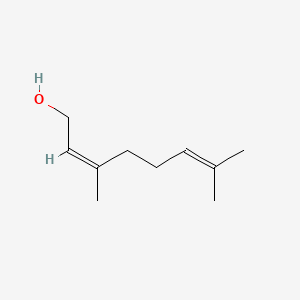| Authors | Title | Published | Journal | PubMed Link |
|---|---|---|---|---|
| Salvi HM et al. | Synthesis of Geraniol Esters in a Continuous-Flow Packed-Bed Reactor of Immobilized Lipase: Optimization of Process Parameters and Kinetic Modeling. | 2018 | Appl. Biochem. Biotechnol. | pmid:28836237 |
| Canbek M et al. | The Effect of Geraniol on Liver Regeneration After Hepatectomy in Rats. | 2017 Mar-Apr | In Vivo | pmid:28358702 |
| El-Bassossy HM et al. | Geraniol alleviates diabetic cardiac complications: Effect on cardiac ischemia and oxidative stress. | 2017 | Biomed. Pharmacother. | pmid:28178614 |
| Zhao J et al. | Dynamic control of ERG20 expression combined with minimized endogenous downstream metabolism contributes to the improvement of geraniol production in Saccharomyces cerevisiae. | 2017 | Microb. Cell Fact. | pmid:28137282 |
| Ahumada K et al. | Aroma Release in Wine Using Co-Immobilized Enzyme Aggregates. | 2016 | Molecules | pmid:27834828 |
| Cho M et al. | The antitumor effects of geraniol: Modulation of cancer hallmark pathways (Review). | 2016 | Int. J. Oncol. | pmid:26983575 |
| Marmulla R et al. | Linalool isomerase, a membrane-anchored enzyme in the anaerobic monoterpene degradation in Thauera linaloolentis 47Lol. | 2016 | BMC Biochem. | pmid:26979141 |
| Tofiño-Rivera A et al. | Effect of Lippia alba and Cymbopogon citratus essential oils on biofilms of Streptococcus mutans and cytotoxicity in CHO cells. | 2016 | J Ethnopharmacol | pmid:27765606 |
| Reis SL et al. | Typical Monoterpenes as Insecticides and Repellents against Stored Grain Pests. | 2016 | Molecules | pmid:26907246 |
| Cao S et al. | A Conserved Odorant Receptor Tuned to Floral Volatiles in Three Heliothinae Species. | 2016 | PLoS ONE | pmid:27163122 |
| Dong L et al. | Monoterpene biosynthesis potential of plant subcellular compartments. | 2016 | New Phytol. | pmid:26356766 |
| Chávez MI et al. | Synthesis and in Vitro Antifungal Activity against Botrytis cinerea of Geranylated Phenols and Their Phenyl Acetate Derivatives. | 2015 | Int J Mol Sci | pmid:26287171 |
| Miyazawa M et al. | Volatile Compounds with Characteristic Odor of Essential Oil from Magnolia obovata Leaves by Hydrodistillation and Solvent-assisted Flavor Evaporation. | 2015 | J Oleo Sci | pmid:26250428 |
| Wittig C et al. | Geraniol Suppresses Angiogenesis by Downregulating Vascular Endothelial Growth Factor (VEGF)/VEGFR-2 Signaling. | 2015 | PLoS ONE | pmid:26154255 |
| Magnard JL et al. | PLANT VOLATILES. Biosynthesis of monoterpene scent compounds in roses. | 2015 | Science | pmid:26138978 |
| Liu W et al. | Utilization of alkaline phosphatase PhoA in the bioproduction of geraniol by metabolically engineered Escherichia coli. | 2015 | Bioengineered | pmid:26091008 |
| Ibrahim SM et al. | Geraniol, alone and in combination with pioglitazone, ameliorates fructose-induced metabolic syndrome in rats via the modulation of both inflammatory and oxidative stress status. | 2015 | PLoS ONE | pmid:25679220 |
| Motooka R et al. | Characteristic odor components of essential oils from Eurya japonica. | 2015 | J Oleo Sci | pmid:25843279 |
| Molińska E et al. | Double bond stereochemistry influences the susceptibility of short-chain isoprenoids and polyprenols to decomposition by thermo-oxidation. | 2015 | Lipids | pmid:25739731 |
| Strube-Bloss MF et al. | Extracting the Behaviorally Relevant Stimulus: Unique Neural Representation of Farnesol, a Component of the Recruitment Pheromone of Bombus terrestris. | 2015 | PLoS ONE | pmid:26340263 |
Nerol
Nerol is a lipid of Prenol Lipids (PR) class. The involved functions are known as Odorant, Anabolism, Diastasis, Metabolic Inhibition and Oxidation. Nerol often locates in germ tube. The related lipids are Octanols, Pinene, Hexanols, ethyl butyrate and ethyl hexanoate.
Cross Reference
Introduction
To understand associated biological information of Nerol, we collected biological information of abnormalities, associated pathways, cellular/molecular locations, biological functions, related genes/proteins, lipids and common seen animal/experimental models with organized paragraphs from literatures.
What diseases are associated with Nerol?
There are no associated biomedical information in the current reference collection.
No disease MeSH terms mapped to the current reference collection.
PubChem Associated disorders and diseases
What pathways are associated with Nerol
There are no associated biomedical information in the current reference collection.
PubChem Biomolecular Interactions and Pathways
Link to PubChem Biomolecular Interactions and PathwaysWhat cellular locations are associated with Nerol?
Visualization in cellular structure
Associated locations are in red color. Not associated locations are in black.
Related references are published most in these journals:
| Location | Cross reference | Weighted score | Related literatures |
|---|
What functions are associated with Nerol?
Related references are published most in these journals:
| Function | Cross reference | Weighted score | Related literatures |
|---|
What lipids are associated with Nerol?
Related references are published most in these journals:
| Lipid concept | Cross reference | Weighted score | Related literatures |
|---|
What genes are associated with Nerol?
There are no associated biomedical information in the current reference collection.
What common seen animal models are associated with Nerol?
There are no associated biomedical information in the current reference collection.
